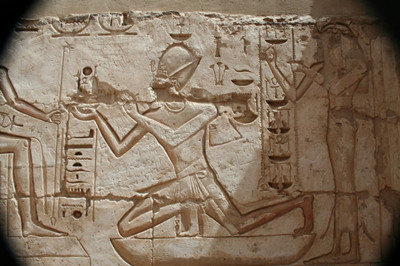The inscriptions give us the name of King Den and, between him and the enemy, are the chilling words 'they shall not exist'. This 'other' is going to be obliterated. Who he is we don't know but, to the right of the label, is an inscription which reads: 'the first occasion of smiting the east'. And, as the sandy ground beneath the figures rises to the right-hand side, it's been suggested that the enemy comes from the east, from Sinai. All the tricks of savage political propaganda are already here-the ruler calm and victorious, the alien misshapen, defeated enemy.
這銘文告訴了我們這法老的名字是丹,然后在他與他的敵人之間是一句令人心寒的話:“他們不得存在。”這些“他們”終將被消滅。雖然我們不知道這里的“他們”指的是誰,不過這標簽的右側刻的是:“第一次東征”。而且在人物形像腳下的沙質地面向東方延伸,這說明了敵人是來自于東部的,有人在猜,也許是西奈半島。總之,這里集中體現了所有野蠻的政治宣傳伎倆:順我者昌,逆我者亡。
The area that this Egyptian state was able to coerce and control is staggering; at its height, it included virtually all the Nile Valley from the Delta to what is modern Sudan, as well as a huge area to the east up to the borders of Sinai. We asked archaeologist Toby Wilkinson what state building on this scale required:
當時埃及國王能夠進行強權統治的疆土范圍之大令人咋舌,在王朝鼎盛時期,幾乎囊括整個尼羅河谷,從三角洲到現代蘇丹,向東直達西奈半島的邊界。我們請教了考古學家托比?威爾金森,到底建設這么大規模的王朝需要什么呢?
"Well obviously this is an early period in Egypt's history, when the nation is still being consolidated, not so much territorially as ideologically and psychologically. And the king and his advisers are looking for ways to reinforce Egypt's sense of its own nationhood, and support for their regime.
“嗯,顯然這是埃及歷史上一個早期的階段,國家仍舊在擴張兼并中,思想上與心理上還沒形成一種固定疆土的理念。法老與他的智囊團不斷地尋找可以進一步強化埃及自身的國家民族意識及支持他們政權的方法。
And I think they realised, as world leaders have realised throughout history, that nothing binds a nation and a people together quite so effectively as a foreign war against a common enemy, whether that enemy is real or manufactured.
我認為他們已經意識到了,作為世界各國領導人都清楚的一點,縱觀歷史,對于一個國家或一個民族而言,沒有什么比團結一致對抗一個共同敵人具有更大的約束力與凝聚力,這敵人真實也好,假想也罷,都無所謂。












